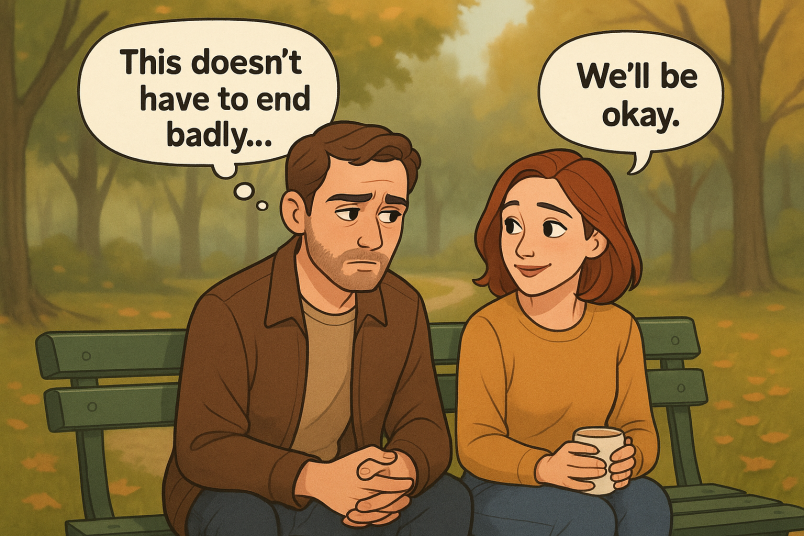What Is Conscious Uncoupling and How to Do It the Right Way

Key Takeaways
Marriage.com AI Quick Summary
What if the end of your relationship didn’t have to feel like failure?
What if, instead of slammed doors, silent resentment, or lawyer-led standoffs, there was a way to part with dignity—and maybe even gratitude?
What if we tell you it’s a growing reality for couples choosing a different path—one rooted in clarity, accountability, and emotional maturity. You might’ve heard the phrase before: conscious uncoupling.
It’s more than just a buzzword.
According to research in the Journal of Positive Psychology, people who approach breakups with mindfulness and intentional communication report greater resilience and emotional recovery than those who go through traditional, high-conflict splits.
In other words, how we separate might be just as important as why.
And in today’s world—where self-awareness and mental health are top of mind—rethinking how we end relationships is more relevant than ever.
In this article, let’s take a closer look at what conscious uncoupling really means, why more couples are turning to it, and how it works.
What is conscious uncoupling?
A few months after their ten-year relationship ended, Maya and Jordan still grabbed coffee on Sundays.
Not because they were clinging to the past—but because they were building a new kind of connection, one based on respect instead of resentment.
No screaming matches. No blame games. Just two people choosing to close one chapter without burning the whole book.
That might sound rare—but it’s exactly the kind of breakup more and more couples are working toward. And at the heart of it is a concept called conscious uncoupling.
Rather than treating separation like a personal failure, conscious uncoupling offers a way to part ways intentionally, with emotional responsibility and mutual respect. It’s not about pretending everything’s fine or forcing a friendship. It’s about giving both people the tools to let go without self-destruction—and maybe even with some healing.
In words of Katherine Woodward Thomas, licensed therapist and author of Conscious Uncoupling: 5 Steps to Living Happily Even After
“Conscious uncoupling is the ability to understand that every irritation and argument was a signal to look inside ourselves and identify a negative internal pattern that needs healing.”
It’s a shift from the drama-filled divorces and ghosted goodbyes we’re used to seeing. Instead, it encourages something many of us didn’t even know was possible: breaking up in a way that’s…well, healthy.
How conscious uncoupling is different from a traditional breakup
According to Maggie Martinez, a licensed clinical social worker:
When we are able to see our faults and our partner’s faults, we can share responsibility for the dissolution of the relationship.
Let’s be honest—when most people think of breakups, they picture drama.
Tense conversations. Ghosted texts. Maybe even legal chaos if marriage or kids are involved. It’s no wonder the idea of separating can feel terrifying.
But conscious uncoupling flips that script.
Instead of reacting from pain, it encourages reflection. Instead of winning the breakup, it focuses on growth—for both people. It’s not a one-size-fits-all solution, but the difference in mindset is huge.
Here’s how it compares:
| Traditional Breakup | Conscious Uncoupling |
|---|---|
| ❌ Blame and emotional reactivity (“You ruined everything.”) | ✅ Ownership and emotional responsibility (“Here’s what I’ve learned about myself.”) |
| ❌ Winning or "being right" becomes the goal | ✅ Growth and peace of mind are prioritized over ego |
| ❌ Often involves harsh cutoffs or ghosting | ✅ Encourages thoughtful closure and communication |
| ❌ Couples rely on friends, lawyers, or social media to vent | ✅ Couples work with therapists, coaches, or mediators for guidance |
| ❌ Lingering resentment or unfinished emotional business | ✅ Clear emotional processing and intentional healing |
| ❌ Focused on the end of the relationship | ✅ Focused on transforming the relationship dynamic—especially important for co-parents or shared communities |
Why are couples turning to conscious uncoupling
For years, breakups were all about the blame game.
One person “won,” the other “lost.” There were sides to pick, dignity to protect, and emotional landmines everywhere.
But lately, the script has been flipping—and not just in self-help books.
When actress Gwyneth Paltrow and musician Chris Martin first used the term conscious uncoupling in 2014, the internet went wild. Some people rolled their eyes, but others saw something refreshing: a couple choosing to separate without destroying each other in the process.
Fast forward a decade, and what was once a Hollywood headline has quietly turned into a cultural shift.
In fact, a 2023 survey found that nearly 42% of divorcing couples aged 30–50 actively sought therapy or mediation to support a healthier separation—a clear sign that many are rethinking what a breakup should look like.
And the science backs it up.
Individuals who feel a sense of agency and emotional closure during their breakup process may show lower levels of post-breakup anxiety and depression.
So why are couples making the switch?
- They’re prioritizing emotional wellness over bitterness.
- They’re co-parenting and need to maintain some level of connection.
- They want to grow from the breakup—not just survive it.
- And frankly? Many are just tired of the drama.
Understand more about emotional closure after separating from a romantic partner. Watch this insightful video:
Who is this approach best for?
Conscious uncoupling isn’t about being overly polite or pretending you’re okay when you’re not.
It works best for couples who are ready to end the relationship, but not at the cost of their emotional health or personal integrity. That might include:
- Long-term partners (married or not) who share deep ties
- Parents who want to co-parent peacefully
- Anyone who values growth over revenge
5 stages of conscious uncoupling and how to cruise through them
Breakups aren’t one-size-fits-all—and neither is healing. Conscious uncoupling isn’t about pretending everything’s fine. It’s about feeling everything fully and moving through the ending with intention, not reactivity.
Below, we walk through the five key emotional stages of conscious uncoupling—not as a rigid formula, but as a flexible, human process. Some stages may overlap, repeat, or look different depending on your circumstances. What matters most is your willingness to move through them honestly.
Stage 1: Facing the emotional storm
Maggie Martinez, LCSW, further shares:
When we stay in a relationship that is unhealthy, we run the risk of getting sicker physically as well.
This is the emotional crash landing. It often arrives with intensity—grief, confusion, guilt, anger, even relief. Whether the breakup was mutual or one-sided, the unraveling of a life together stirs up everything. You may feel emotionally raw or completely numb. Both are valid.
This stage is about allowing those feelings to surface, rather than stuffing them down or intellectualizing them. When we meet the storm instead of running from it, we begin to clear the path for deeper healing.
- Real moment
Maya kept reaching for her phone to text Jordan, forgetting they no longer shared a life in the same way. She’d burst into tears at a car commercial or feel unexpectedly calm—then guilty for feeling okay. It made no sense, until she realized that healing rarely does. - Reflection prompt
What am I feeling right now—and can I allow myself to feel it without judgment?
Stage 2: Taking ownership without shame
After the initial emotional waves, there’s a quiet but powerful opportunity: looking inward. This stage invites you to examine your part in the relationship—your patterns, fears, communication styles—not to blame, but to understand.
It can be tempting to paint ourselves as the victim or the villain. Conscious uncoupling offers a more balanced view: we each contribute to the relational dance. This stage helps you reclaim agency by learning from the experience rather than being defined by it.
- Real moment
Darren realized he’d spent most of the relationship avoiding conflict—agreeing to things he didn’t want, silently resenting what he didn’t express. It wasn’t all on him, but owning that pattern became a breakthrough, not a burden. - Takeaway tip
What role did I play—and what would taking responsibility look like without beating myself up?
Stage 3: Rewriting the story
Breakups often come with a heavy narrative: “I wasn’t enough.” “They ruined everything.” This stage asks you to challenge those stories. Instead of clinging to painful labels or turning your relationship into a cautionary tale, you get to reshape what the story means.
This isn’t about toxic positivity. It’s about pulling meaning from your experience, honoring what was real, and deciding what parts of the story no longer serve you. Language matters. Perspective matters more.
- Real moment
Jasmin used to say her marriage “fell apart.” After months of reflection, she started saying it “ran its course.” That shift didn’t erase her grief—but it helped her hold it with less shame. - Reflection prompt
What version of this story have I been telling? And what truth might feel more honest and more empowering?
Stage 4: Finding freedom through forgiveness
Forgiveness is often misunderstood. It doesn’t mean condoning harm or rushing to “make peace.” In conscious uncoupling, forgiveness is about liberation—releasing the energetic grip of resentment, blame, and unresolved hurt, so you can truly move forward.
Sometimes, forgiveness is extended to your ex. Often, it’s extended to yourself—for what you did, what you didn’t do, what you didn’t know then. This stage may take time, but it opens the door to deep emotional freedom.
- Real moment
Even after the papers were signed, Daniel still replayed old fights in his head. Letting go didn’t mean pretending it didn’t hurt. It meant choosing not to carry that hurt into his future. - Takeaway tip
What would it feel like to stop hoping the past turns out differently? What can I release today, even if just a little?
Stage 5: A new kind of connection (or closure)
Not all endings mean cutting ties completely. For some, especially co-parents or long-term partners, conscious uncoupling leads to a different kind of connection—one based on respect, not romance. For others, it leads to a clean but kind closure.
Either way, this final stage is about clarity. You know who you are, what you’ve learned, and what boundaries you need going forward. Whether or not you stay in contact, you’ve closed the chapter with presence, not avoidance.
- Real moment:
Six months later, Anita no longer flinched when her ex’s name came up. There was no bitterness, no ache—just a soft exhale. She didn’t wish to go back. She just felt… complete. - Reflection prompt:
What does closure mean to me—and how can I give that to myself instead of waiting for someone else to offer it?
FAQs
Here are some additional questions on understanding this concept in a bit more detail:
- Can you consciously uncouple alone?
At times unconsciously, couples start to drift apart or want different things. This could mean you are headed toward a breakup; one person may figure this out before the other.
This could be when you think about uncoupling, although it isn’t something that is designed to be done by one person. At the same time, if you are going through the steps and working through the emotions you have around your relationship, it may be possible to start the process alone.
It is also important to note that any relationship can benefit from uncoupling this way, not just marriages.
Anytime you feel like you are headed towards a breakup or divorce, you can opt for couples counseling to guide you through the process. This could help you work out your problems or determine the best way to end your relationship with one another.
- Is conscious uncoupling healthy?
In the past, there weren’t many ways to break up or divorce that didn’t end up with both parties getting hurt or arguing about everything. This is what makes conscious uncoupling a healthy thing.
Instead of fighting about the end of your relationship, you can instead talk about what could have been done differently by both of you.
This can also allow you to own up to your mistakes so you can learn from them. It could even allow you both to be civil with each other, effectively work through your feelings, and be able to care and communicate for each other, even when you are no longer together.
Final takeaway: Upcouple, but not uproot your life
Conscious uncoupling is more than a term used by celebrities. It is an approach to breaking up or getting divorced that allows you to work through your problems and issues with one another without being bitter or fighting about them.
Maggie Martinez highlights that:
Conscious uncoupling means letting go of something in the hopes that there is something better in the future.
After all, you and your partner may have been friends at some time, and it would probably feel good to continue being their friend, even if there’s no relationship anymore.
Try your best to work through the steps listed above, read more information about this topic, and talk to a therapist if you need additional help. Approaching the situation this way is possible, although it may take some work on your part.
 Tips
Tips
Write your tip or submit a video tip
All tips are reviewed before the publishing.
Share this article on
Want to have a happier, healthier marriage?
If you feel disconnected or frustrated about the state of your marriage but want to avoid separation and/or divorce, the marriage.com course meant for married couples is an excellent resource to help you overcome the most challenging aspects of being married.
Recent Articles
Related Quizzes
 We'd love your feedback!
We'd love your feedback!
 Expert Q&A
Expert Q&A
Ask your question related to this topic & get the support you deserve from experts.





















 Thanks for your feedback!
Thanks for your feedback!